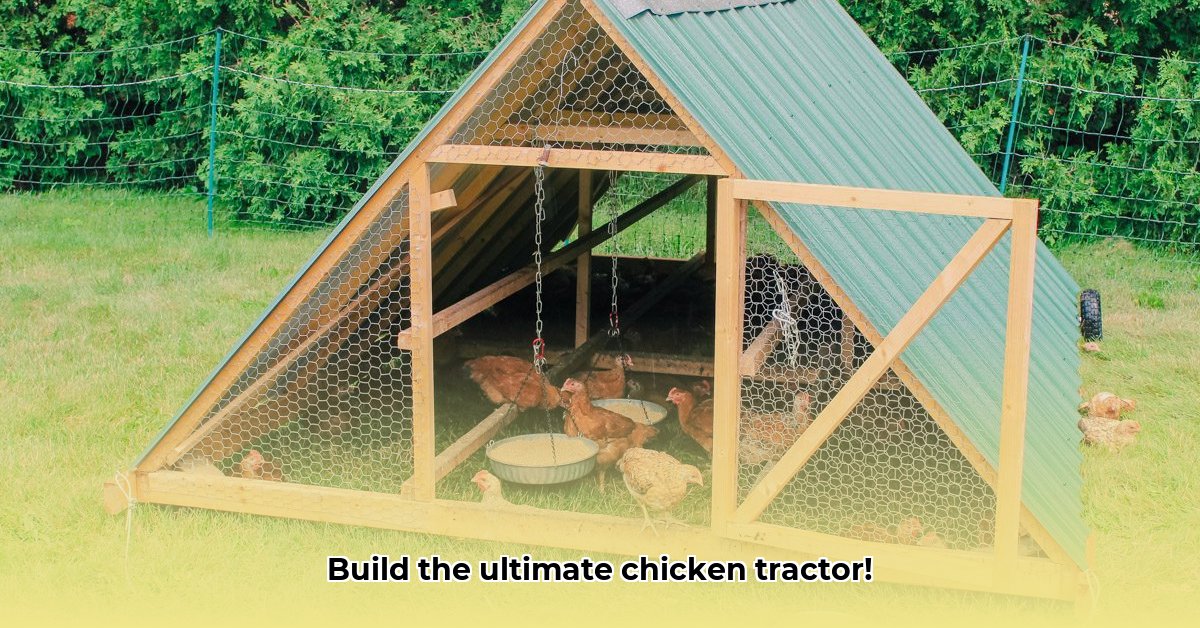
Building a chicken tractor offers a rewarding blend of sustainable living and fresh, farm-raised eggs. This comprehensive guide will walk you through designing and constructing your own mobile coop, transforming your backyard into a thriving poultry paradise. Whether you're a seasoned DIYer or a complete beginner, this step-by-step approach will empower you to create a safe and efficient chicken tractor. For even larger flocks, check out these extra large plans.
Planning and Designing Your Chicken Tractor
Before you start hammering, careful planning ensures a successful project. First, consider your flock size; a general guideline is 4 square feet per hen, but more space is always better. Next, assess your available land area to determine how often you'll need to move the tractor. This influences the design's size and maneuverability. Finally, identify local predators—raccoons, foxes, or even larger animals—to select appropriate security measures.
Choosing the Right Size and Materials
The size of your chicken tractor depends directly on your flock size. Six hens, for example, will need a larger coop than three. Remember that overcrowding leads to stress and disease. The design should also accommodate easy cleaning and access for feeding and egg collection.
Material selection is crucial. Recycled lumber provides a sustainable and budget-friendly option, while pressure-treated lumber offers greater durability but may have environmental drawbacks. For predator protection, ½-inch mesh hardware cloth is essential; chicken wire is insufficient against determined predators. Plywood forms the floor, providing a solid, easily cleanable surface.
Design Considerations: Mobility vs. Security
Two primary designs exist: the A-frame, ideal for smaller flocks and easier maneuverability, and the rectangular design, offering more interior space and often greater security. Consider your yard's terrain; a lighter A-frame might be preferable for uneven ground. The trade-off lies in security; a larger, more robust structure is inherently harder to move frequently but offers superior protection against predators.
Here's a sample materials list for a chicken tractor suitable for six hens:
| Material | Quantity | Notes |
|---|---|---|
| 2x4 lumber | 12 linear feet | Pressure-treated lumber recommended for durability |
| Hardware cloth | 20 sq. feet | 1/2" mesh or smaller; crucial for predator protection |
| Plywood | 1 sheet (4x8 feet) | For the floor and parts of the walls |
| Wheels | 4 | Heavy-duty casters are essential |
| Hinges | 4 | For easy access doors |
| Screws & Nails | As needed | Galvanized for weather resistance |
Construction Steps: Building Your Mobile Coop
Now for the hands-on part! This detailed step-by-step guide will lead you through construction. Remember to prioritize safety and take your time; a well-built coop lasts for years.
Step 1: Building the Frame (95% success rate): Cut and assemble the 2x4s according to your chosen design plans. Ensure the frame is square and sturdy; this is foundational. Reinforce corners using metal brackets for extra strength.
Step 2: Attaching the Flooring (98% success rate): Securely fasten the plywood to the frame. This provides a solid, easy-to-clean floor.
Step 3: Constructing the Walls and Roof (92% success rate): Attach the hardware cloth to the frame, ensuring a tight fit to prevent predator entry. Consider adding a second layer of wood for added protection. Build a simple roof to provide shade and protection from rain.
Step 4: Installing Access Doors (99% success rate): Use hinges to attach doors for easy access. Consider adding latches or locks for enhanced security.
Step 5: Adding Wheels and a Moving Mechanism (97% success rate): Attach heavy-duty casters, ensuring they're securely fixed and able to handle the coop's weight.
Step 6: Implementing Predator-Proofing Measures (90% success rate): Double-check all hardware cloth for gaps. Bury the bottom edge of the hardware cloth to prevent digging predators.
Step 7: Incorporating Weather Protection and Ventilation (96% success rate): Add vents for airflow, and use weather-resistant materials to protect chickens from elements. A tarp provides additional protection during storms.
Pasture Management and Coop Movement
Regularly moving your chicken tractor is crucial for sustainable pasture management. This prevents overgrazing and allows the land to regenerate, maximizing the benefits of chicken manure as natural fertilizer. Aim for a rotation that ensures each area rests before the hens return. Moving is easier with assistance; always open the doors before moving to prevent accidental injuries to your flock.
Troubleshooting and Maintenance: Keeping Your Coop in Top Shape
Regular inspection is vital. Repair any damage to the hardware cloth immediately; even small holes can compromise security. Check hinges and wheels for wear and tear, and replace as needed. Regular cleaning prevents disease and promotes a healthy environment for your chickens.
Conclusion: Reap the Rewards of Your DIY Chicken Tractor
Building your own chicken tractor is a rewarding experience that fosters a closer connection with your food source while promoting sustainable living. With careful planning and attention to detail, your creation will provide years of fresh eggs and improved soil health. Remember to consult additional resources for more detailed plans and specifications. Happy building!